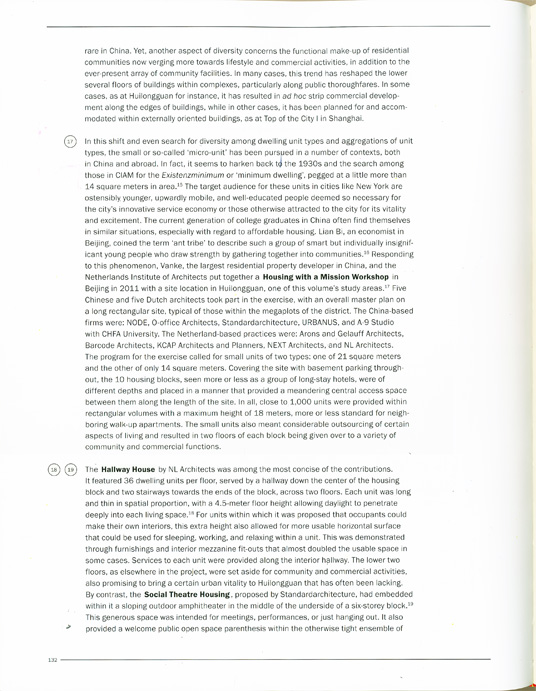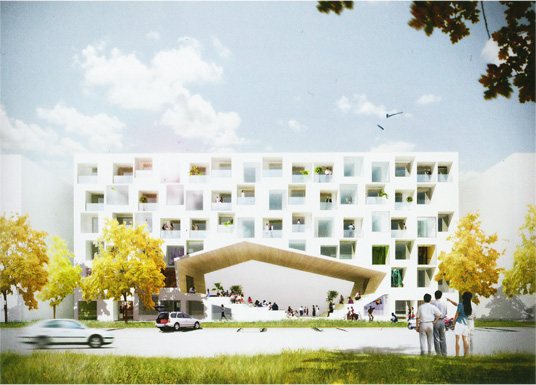China's Urban Communities
06 June 2016



Seeking Unit Diversity
In this shift and even search for diversity among dwelling unit types and aggregations of unit types, the small or so-called ‘micro-unit’ has been pursued in a number of contexts, both in China and abroad. In fact, it seems to harken back to the 1930s and the search among those in CIAM for the Existenzminimum or ‘minimum dwelling’ , pegged at a little more than 14 square meters in area. The target audience for these units in cities like New York are ostensibly younger, upwardly mobile, and well-educated people deemed so necessary for the city's innovative service economy or those otherwise attracted to the city for its vitality and excitement. The current generation of college graduates in China often find themselves in similar situations, especially with regard to affordable housing. Lian Bi, an economist in Beijing, coined the term ‘ant tribe’ to describe such a group of smart but individually insignificant young people who draw strength by gathering together into communities.Responding to this phenomenon, Vanke, the largest residential property developer in China, and the Netherlands Institute of Architects put together a Housing with a Mission Workshop in Beijing in 2011 with a site location in Huilongguan, one of this volume's study areas. Five Chinese and five Dutch architects took part in the exercise, with an overall master plan on a long rectangular site, typical of those within the megaplots of the district. The China-based firms were: NODE, O-office Architects, Standardarchitecture, URBANUS, and A-9 Studio with CHFA University. The Netherland-based practices were: Arons and Gelauff Architects, Barcode Architects, KCAP Architects and Planners, NEXT Architects, and NL Architects. The program for the exercise called for small units of two types: one of 21 square meters and the other of only 14 square meters. Covering the site with basement parking through-out, the 10 housing blocks, seen more or less as a group of long-stay hotels, were of different depths and placed in a manner that provided a meandering central access space between them along the length of the site. In all, close to 1,000 units were provided within rectangular volumes with a maximum height of 18 meters, more or less standard for neigh-boring walk-up apartments. The small units also meant considerable outsourcing of certain aspects of living and resulted in two floors of each block being given over to a variety of community and commercial functions.
The Hallway House by NL Architects was among the most concise of the contributions. It featured 36 dwelling units per floor, served by a hallway down the center of the housing block and two stairways towards the ends of the block, across two floors. Each unit was long and thin in spatial proportion, with a 4.5-meter floor height allowing daylight to penetrate deeply into each living space. For units within which it was proposed that occupants could make their own interiors, this extra height also allowed for more usable horizontal surface that could be used for sleeping, working, and relaxing within a unit. This was demonstrated through furnishings and interior mezzanine fit-outs that almost doubled the usable space in some cases. Services to each unit were provided along the interior hallway. The lower two floors, as elsewhere in the project, were set aside for community and commercial activities, also promising to bring a certain urban vitality to Huilongguan that has often been lacking. By contrast, the Social Theatre Housing, proposed by Standardarchitecture, had embedded within it a sloping outdoor amphitheater in the middle of the underside of a six-storey block. This generous space was intended for meetings, performances, or just hanging out. It also provided a welcome public open space parenthesis within the otherwise tight ensemble of building blocks. Each unit also had a small exterior-facing balcony across its fac111ade. Among the schemes, four had very thin profiles in block width, whereas the other six were bulkier, aggregating more units together perpendicular to the outside faces of the building.